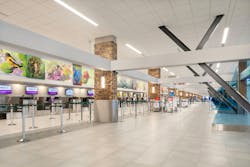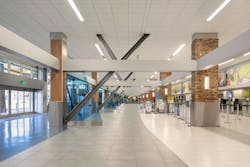Building Resilient Airports: Mark Crosby on Infrastructure Gaps, Modernization, and Smarter Project Delivery
Five Things You'll Learn from this Article
- Airports must enhance collaboration among stakeholders to maintain reliability during disruptions caused by labor shortages and aging infrastructure.
- Flexible project delivery methods like design-build help control costs and reduce operational disruptions during modernization efforts.
- Sustainability is integrated into every project, with dedicated teams ensuring facilities are adaptable and long-lasting.
- AI and advanced scheduling tools are revolutionizing construction management, reducing bureaucracy, and accelerating project timelines.
- Clear timelines and decision-making criteria are essential for keeping airport capital programs on track and within budget.

Mark Crosby, Vice President of Aviation, McCarthy Building Companies
North American airports are under mounting pressure to modernize. Between record-breaking travel demand, outdated facilities, evolving passenger expectations, and uncertain federal funding, the aviation industry faces one of the most complex infrastructure moments in decades.
To explore how airports can strengthen resilience, adopt smarter project delivery models, and align modernization with long-term passenger needs, Airport Business spoke with Mark Crosby, Vice President of Aviation for McCarthy Building Companies. With more than 30 years of experience across airport operations, consulting, and construction, Crosby offers a unique 360-degree perspective on managing large-scale aviation projects.
Airport Business: Coming out of the summer travel surge, what lessons have airports learned about resilience and capacity?
Mark Crosby: The biggest lesson is that nothing is certain anymore. Challenges in labor, aging airport infrastructure, and air traffic control are all converging at once. Any one of those factors can disrupt the customer experience. What we’ve seen is the need for closer collaboration—between airport operators, government, vendors, and contractors—to ensure that the passenger experience remains reliable even during disruptions.
AB: Where do you see the most urgent infrastructure gaps that airports need to address?
MC: It depends on each airport’s recapitalization stage, but terminals, runways, and technology all demand attention. Many facilities were built in the 1960s and 70s, and not all have kept pace with growth. A concourse expansion, for example, only works if the runway can handle new demand. Funding is the real challenge—federal boosts like pandemic recovery programs are fading, and smaller airports struggle more than large hubs to secure bonds. Adjusting the passenger facility charge, which hasn’t changed since the early 1990s, may be one of the few viable options to close the gap.
AB: What makes modernization so difficult while keeping operations seamless for travelers?
MC: Airports are becoming more complex. Many staff haven’t managed billion-dollar projects before, so there’s hesitation. Traditional “hard bid” processes aren’t enough anymore. Alternative delivery methods—construction manager at risk, design-build, and progressive design-build—allow us to adapt during the process, control costs, and reduce disruption. Flexibility is key, especially with technology and sustainability evolving so quickly.
AB: How are contractors adapting project delivery to minimize disruption in day-to-day operations?
MC: We often draw lessons from other sectors, like healthcare. A hospital campus operates much like an airport—it’s a 24/7 community with complex logistics. In those projects, progressive design-build methods have shown real benefits in speed and cost. The challenge in aviation is working within government funding frameworks and FAA oversight, but it’s about educating stakeholders and building trust to try new approaches.
AB: What best practices help keep projects on time and on budget?
MC: Collaborative project delivery is the key. That means building strong partnerships between contractors, designers, and airport authorities. The “big room” concept—getting everyone in the same space to problem-solve early—helps reduce miscommunication and delays. You need constant but efficient communication. Trust and long-term relationships make these projects succeed.
AB: How do sustainability and resiliency factor into airport design today?
MC: Sustainability is no longer an add-on—it’s part of every project. Teams now include subject matter experts in sustainability and innovation to ensure facilities adapt to new technologies and last 40 years instead of 20. Airports are even creating staff positions focused solely on sustainability and innovation, which helps bring best practices from other industries into aviation.
AB: From your unique background across operations, consulting, and construction, how does that perspective shape your approach?
MC: It gives me credibility with airport directors I’ve known for decades. They trust that I understand the pressures they face because I’ve been in their chair. That trust makes it easier to introduce alternative delivery methods or new ideas. Conferences and industry associations help reinforce that trust by sharing what’s working elsewhere and bringing the FAA along in the conversation.
AB: Can you share a project example that highlights collaboration as a success factor?
MC: At Reno-Tahoe International Airport, we renovated the ticketing hall—a $30 million project that directly impacted the passenger front door. We phased construction carefully to keep operations moving, and our frontline staff even won the airport’s “Employee of the Month” award for helping passengers during disruption. That trust built credibility, which led to us being awarded Reno’s largest project ever—their new terminal redevelopment.
AB: What passenger experience trends are shaping the next generation of airport facilities?
MC: The push is toward fewer touchpoints and a seamless journey—from parking to security to concessions. The challenge is that each element is managed by different entities, and the airport operator must serve as the glue. The goal is a consistent, predictable experience across airports, regardless of size.
AB: Which innovations in construction or project management excite you most right now?
MC: AI has huge potential. We’re already using it to improve pricing models and scheduling, which helps control costs and adapt quickly when scopes change. Anything that can reduce bureaucracy and accelerate delivery is going to benefit both contractors and airports.
AB: If you could offer one piece of advice to airport executives planning capital programs today, what would it be?
MC: Hold your timelines and be clear in your selection criteria. We invest significant resources in proposals, and the best outcomes come from owners who provide clarity and stick to decisions. Like airlines that only make money when planes are in the air, contractors only make money when we’re building. Clear direction, consistent timelines, and openness to alternative delivery methods are what will keep projects moving.
About the Author
Joe Petrie
Editor & Chief
Joe Petrie is the Editorial Director for the Endeavor Aviation Group.
Joe has spent the past 20 years writing about the most cutting-edge topics related to transportation and policy in a variety of sectors with an emphasis on transportation issues for the past 15 years.
Contact: Joe Petrie
Editor & Chief | Airport Business
+1-920-568-8399
>> To download the AviationPros media kits, visit: Marketing Resource Center
>>Check out our aviation magazines: Ground Support Worldwide | Airport Business | Aircraft Maintenance Technology


